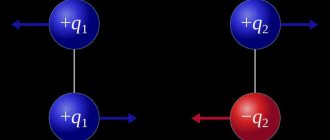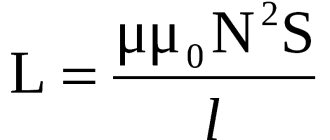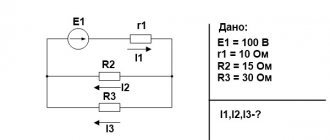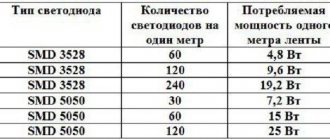What is EMF: explanation in simple words
EMF is understood as the specific work of external forces to move a single charge in the circuit of an electrical circuit. This concept in electricity involves many physical interpretations related to various areas of technical knowledge. In electrical engineering, this is the specific work of external forces that appears in inductive windings when an alternating field is induced in them. In chemistry, it means the potential difference that occurs during electrolysis, as well as during reactions accompanied by the separation of electrical charges.
What is a photoresistor?
Read more
Marking of SMD transistors.
Read more
How to make a motion sensor with your own hands.
Read more
In physics, it corresponds to the electromotive force created at the ends of an electrical thermocouple, for example. To explain the essence of EMF in simple words, you will need to consider each of the options for its interpretation. Before moving on to the main part of the article, we note that EMF and voltage are very similar concepts in meaning, but they are still somewhat different. In short, the EMF is on the power source without a load, and when a load is connected to it, it is already a voltage. Because the number of volts on the power supply under load is almost always slightly less than without it. This is due to the internal resistance of power sources such as transformers and galvanic cells.
Additional material on the topic: In simple words about voltage converters.
Electromotive force (emf), a physical quantity characterizing the action of third-party (non-potential) forces in direct or alternating current sources; in a closed conducting circuit is equal to the work of these forces to move a single positive charge along the circuit. If we denote the field strength of external forces by Etr, then the emf in a closed loop (L) is equal to , where dl is the element of the loop length. The potential forces of an electrostatic (or stationary) field cannot maintain a constant current in the circuit, since the work of these forces on a closed path is zero. The passage of current through the conductors is accompanied by the release of energy - heating of the conductors.
Third-party forces set in motion charged particles inside current sources: generators, galvanic cells, batteries, etc. The origin of third-party forces can be different. In generators, external forces are forces from the vortex electric field that arises when the magnetic field changes over time, or the Lorentz force acting from the magnetic field on electrons in a moving conductor; in galvanic cells and batteries - these are chemical forces, etc. Emf determines the current strength in the circuit at a given resistance (see Ohm's law). EMF, like voltage, is measured in volts.
What is EMF.
Nature of EMF
The reason for the occurrence of EMF in different current sources is different. Based on the nature of occurrence, the following types are distinguished:
- Chemical emf. Occurs in batteries and accumulators due to chemical reactions.
- Thermo EMF. Occurs when contacts of dissimilar conductors located at different temperatures are connected.
- Induction emf. Occurs in a generator when a rotating conductor is placed in a magnetic field. An emf will be induced in a conductor when the conductor crosses the lines of force of a constant magnetic field or when the magnetic field changes in magnitude.
- Photoelectric emf. The occurrence of this EMF is facilitated by the phenomenon of external or internal photoelectric effect.
- Piezoelectric emf. EMF occurs when substances are stretched or compressed.
It will be interesting➡ What is step voltage and why is it dangerous?
Electromagnetic induction (self-induction)
Let's start with electromagnetic induction. This phenomenon is described by Faraday's law of electromagnetic induction. The physical meaning of this phenomenon is the ability of an electromagnetic field to induce an emf in a nearby conductor. In this case, either the field must change, for example, in the magnitude and direction of the vectors, or move relative to the conductor, or the conductor must move relative to this field. In this case, a potential difference arises at the ends of the conductor.
Experience demonstrates the appearance of EMF in a coil when exposed to a changing magnetic field of a permanent magnet. There is another phenomenon that is similar in meaning - mutual induction. It lies in the fact that a change in the direction and current strength of one coil induces an EMF at the terminals of a nearby coil; it is widely used in various fields of technology, including electrical and electronics. It underlies the operation of transformers, where the magnetic flux of one winding induces current and voltage in the second.
What is self-induction.
In electrical engineering, a physical effect called EMF is used in the manufacture of special AC converters that provide the required values of effective quantities (current and voltage). Thanks to the phenomena of induction and self-induction, engineers have been able to develop many electrical devices: from a conventional inductor (inductor) to a transformer. The concept of mutual induction refers only to alternating current, the flow of which in a circuit or conductor changes the magnetic flux.
Table of parameters of electromotive force of induction.
Electromagnetic induction (self-induction)
Let's start with electromagnetic induction. This phenomenon is described by Faraday's law of electromagnetic induction. The physical meaning of this phenomenon is the ability of an electromagnetic field to induce an emf in a nearby conductor. In this case, either the field must change, for example, in the magnitude and direction of the vectors, or move relative to the conductor, or the conductor must move relative to this field. In this case, a potential difference arises at the ends of the conductor.
There is another phenomenon that is similar in meaning - mutual induction. It lies in the fact that a change in the direction and current strength of one coil induces an EMF at the terminals of a nearby coil; it is widely used in various fields of technology, including electrical and electronics. It underlies the operation of transformers, where the magnetic flux of one winding induces current and voltage in the second.
In electrical engineering, a physical effect called EMF is used in the manufacture of special AC converters that provide the required values of effective quantities (current and voltage). Thanks to the phenomena of induction and self-induction, engineers have been able to develop many electrical devices: from a conventional inductor (inductor) to a transformer.
The concept of mutual induction refers only to alternating current, the flow of which in a circuit or conductor changes the magnetic flux.
An electric current of constant direction is characterized by other manifestations of this force, such as, for example, a potential difference at the poles of a galvanic cell, which we will discuss later.
EMF in everyday life and units of measurement
Other examples are found in the practical life of any ordinary person. This category includes such familiar things as small batteries, as well as other miniature batteries. In this case, the working EMF is formed due to chemical processes occurring inside constant voltage sources. When it occurs at the terminals (poles) of the battery due to internal changes, the element is completely ready for operation. Over time, the EMF decreases slightly, and the internal resistance increases noticeably.
As a result, if you measure the voltage on a AA battery that is not connected to anything, you see the normal 1.5V (or so), but when a load is connected to the battery, let’s say you installed it in some device, it does not work. Why? Because if we assume that the voltmeter’s internal resistance is many times higher than the internal resistance of the battery, then you measured its EMF. When the battery began to supply current to the load at its terminals, it became not 1.5V, but, say, 1.2V - the device did not have enough voltage or current for normal operation.
Calculation of EMF.
It was precisely these 0.3 V that dropped on the internal resistance of the galvanic element. If the battery is very old and its electrodes are destroyed, then there may be no electromotive force or voltage at all at the battery terminals - i.e. zero. A very small electromotive force is induced within the receiver antenna, which is then amplified by special cascades, and we receive our television, radio and even Wi-Fi signal.
Material on the topic: Selecting a digital-to-analog converter.
Difference Between Electromotive Force (EMF) and Voltage
The emf is generated by the source.
Voltage
It is simply the potential difference between two points in a circuit.
Electromotive force is different from the output voltage of a device when current flows. The voltage at the battery terminals, for example, is less than the emf when the battery is delivering current, and it decreases as the battery discharges. However, if the device's output voltage is measured without drawing current, the device's output voltage will be equal to the emf, even for a very discharged battery.
How is EMF formed?
The ideal source of EMF is a generator whose internal resistance is zero and the voltage at its terminals does not depend on the load. The power of an ideal EMF source is infinite. A real EMF source, unlike an ideal one, contains an internal resistance Ri and its voltage depends on the load (Fig. 1, b), and the power of the source is finite. The electrical circuit of a real EMF generator is a series connection of an ideal EMF generator E and its internal resistance Ri.
It will be interesting➡ What is electric power and how to calculate it
In practice, in order to bring the operating mode of a real EMF generator closer to the operating mode of an ideal one, they try to make the internal resistance of the real generator Ri as small as possible, and the load resistance Rн must be connected with a value no less than 10 times greater than the internal resistance of the generator, i.e. it is necessary to fulfill the condition: Rн >> Ri
To ensure that the output voltage of a real EMF generator does not depend on the load, it is stabilized using special electronic voltage stabilization circuits. Since the internal resistance of a real EMF generator cannot be made infinitely small, it is minimized and made standard for the possibility of coordinated connection of energy consumers to it. In radio engineering, the standard output resistance of EMF generators is 50 Ohms (industrial standard) and 75 Ohms (household standard).
For example, all television receivers have an input impedance of 75 Ohms and are connected to the antennas with a coaxial cable of exactly this impedance. To get closer to ideal EMF generators, supply voltage sources used in all industrial and household electronic equipment are made using special electronic output voltage stabilization circuits, which make it possible to maintain an almost constant output voltage of the power source in a given range of currents consumed from the EMF source (sometimes its called a voltage source).
On electrical diagrams, EMF sources are depicted as follows: E - source of constant EMF, e(t) - source of harmonic (variable) EMF in the form of a function of time. The electromotive force E of a battery of identical elements connected in series is equal to the electromotive force of one element E multiplied by the number n of elements of the battery: E = nE.
Direct current and EMF.
Electromotive force (EMF) of the energy source
To maintain an electric current in a conductor, an external energy source is required, which constantly creates a potential difference between the ends of this conductor. Such energy sources are called electrical energy sources (or current sources). Sources of electrical energy have a certain electromotive force (abbreviated EMF), which creates and maintains a potential difference between the ends of the conductor for a long time.
Expert commentary
Lagutin Vitaly Sergeevich
Engineer with a degree in Computer Software and Automated Systems, MEPhI, 2005–2010.
Ask a Question
It is sometimes said that emf creates an electric current in a circuit. We must remember that this definition is conventional, since we have already established above that the reason for the emergence and existence of electric current is the electric field.
A source of electrical energy produces a certain amount of work by moving electrical charges throughout a closed circuit. The unit of measurement of electromotive force is the volt (abbreviated volt is denoted by the letter B or V - “ve” in Latin). The emf of a source of electrical energy is equal to one volt if, when moving one coulomb of electricity throughout a closed circuit, the source of electrical energy does work equal to one joule:
Electromotive force (EMF) of an energy source.
In practice, both larger and smaller units are used to measure EMF, namely:
- 1 kilovolt (kV, kV), equal to 1000 V;
- 1 millivolt (mV, mV), equal to one thousandth of a volt (10-3 V),
- 1 microvolt (μV, μV), equal to one millionth of a volt (10-6 V).
Obviously, 1 kV = 1000 V; 1 V = 1000 mV = 1,000,000 μV; 1 mV = 1000 µV.
Currently, there are several types of electrical energy sources. For the first time, a galvanic battery was used as a source of electrical energy, consisting of several zinc and copper circles, between which skin soaked in acidified water was laid. In a galvanic battery, chemical energy was converted into electrical energy (this will be discussed in more detail in Chapter XVI). The galvanic battery got its name from the Italian physiologist Luigi Galvani (1737-1798), one of the founders of the doctrine of electricity.
Numerous experiments on the improvement and practical use of galvanic batteries were carried out by the Russian scientist Vasily Vladimirovich Petrov. At the beginning of the last century, he created the world's largest galvanic battery and used it for a number of brilliant experiments. Sources of electrical energy that work on the principle of converting chemical energy into electrical energy are called chemical sources of electrical energy.
Good to know: How to calculate the power of an electric current.
Another main source of electrical energy, widely used in electrical and radio engineering, is the generator. In generators, mechanical energy is converted into electrical energy. In chemical sources of electrical energy and in generators, the electromotive force manifests itself in the same way, creating a potential difference at the source terminals and maintaining it for a long time.
These terminals are called the poles of the electrical energy source. One pole of an electrical energy source has a positive potential (lack of electrons), is indicated by a plus sign (+) and is called the positive pole.
The other pole has a negative potential (excess electrons), is indicated by a minus sign (—) and is called the negative pole. From sources of electrical energy, electrical energy is transmitted through wires to its consumers (electric lamps, electric motors, electric arcs, electric heating devices, etc.).
It will be interesting➡ What is current density?
Examples of problem solving
For each position in the first column, select the corresponding position in the second:
| PHYSICAL QUANTITIES | FORMULAS |
| Electromotive force | |
| Current strength | |
| Resistance | |
| Potential difference |
Solution: The electromotive force of a galvanic cell is a quantity numerically equal to the work of external forces when moving a single positive charge inside the element from one pole to the other.
The work of external forces cannot be expressed through a potential difference, since external forces are non-potential and their work depends on the shape of the trajectory of the charges.
EMF is determined by the formula:
The current strength is determined by the formula:
Resistance is determined by the formula:
The potential difference is determined by the formula:
Correct answer:
| PHYSICAL QUANTITIES | FORMULAS |
| Electromotive force | |
| Current strength | |
| Resistance | |
| Potential difference |
FAQ
What is electromotive force?
This is the ratio of the work of external forces when moving a charge along a closed circuit to the absolute value of this charge.
What is an electrical circuit?
A set of devices that are connected by conductors, designed to allow current to flow.
What does Ohm's law sound like for a complete circuit?
The current strength in a complete circuit is equal to the ratio of the circuit's emf to its total resistance.
Electromotive force (EMF) function
Electromotive force is the potential difference created by a voltage source and is necessary for current to flow through a circuit.
Strictly speaking, this potential difference in the open circuit of a battery, generator, etc. An alternative definition is that the emf is equal to the sum of the voltage drops around any closed loop, including any internal voltage drop.
The main function of EMF in a circuit:
- Converting electrical energy into some other form.
- Convert another form of energy into electrical energy.











